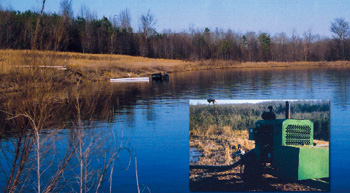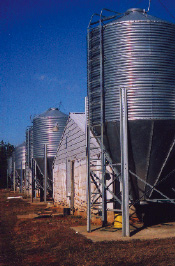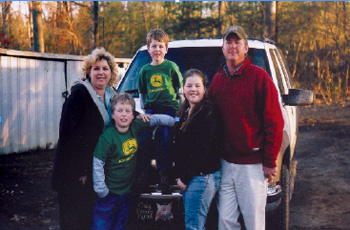
With the hurdles of establishing
their hog operation now well in the past, the Craig family farm in
North Carolina is now working towards setting up a custom separator
system and a composting operation.
 Once a custom separator system is installed at the Craig farm, liquids exiting the separator will flow down to the lagoon. The lagoon, in effect, will become more of a finishing pond. Once a custom separator system is installed at the Craig farm, liquids exiting the separator will flow down to the lagoon. The lagoon, in effect, will become more of a finishing pond. |
With the hurdles of establishing their hog operation now well in the past, the Craig family farm in North Carolina is now working towards setting up a custom separator system and a composting operation.
North Carolina hog farmer Tim Craig is one heck of a persistent guy—and that’s good for both the hog industry in the state, and outside of North Carolina. It’s a while back now, but Tim took on local government and special interest groups to establish a medium-sized hog operation in Chatham County, about an hour southeast of Raleigh. It was, in fact, one of the last hog farms set up before the moratorium on hog farms was imposed in the state.
The lengthy legal fight was a trying time, recall Tim and his wife, Wendy. “We were in limbo for four years of court battles,” says Tim. “We had no idea what we were in for.”
This all took its toll, says Wendy. “I don’t how many people would have persevered,” she says. “I wanted to give up some days, and Tim wanted to give up some days. But we hadn’t done anything wrong.”
Shortly after they bought the 200-acre farm—and before putting a single hog, let alone a barn, on the property—they were sued for prospective nuisance. “We had hardly stepped on the property and the legal battle was on,” says Tim. This was followed, in turn, by an easement dispute.
“In the meantime, there was a big breach with a hog operation on the North Carolina coast, and it was at the exact same time when we closed on our loan. That breach made the news, and it all started to snowball. It was awful.”
Despite all the local legal wrangling going on, the Craigs already had their state permit. They were well down the path of taking all the right steps to make sure the site would be appropriate for a hog operation. They carried out soil sampling and hired an outside engineer to design and oversee the construction of the lagoon and pipe installation. Compaction and permeability tests were carried out on the lagoon dam. The local division of Soil and Water was also involved all the way along.
In spite of this, and even though they already had their permit, the county introduced new rules and regulations governing hog farms. “What we challenged is that the county can not supersede the state’s rules and regulations,” says Tim.
As the legal battle lines were drawn, it was quickly evident that the Craigs were not only fighting for their own rights to run a hog operation, but for others, as well. Tim received a number of phone calls from hog producers—both in North Carolina and outside of the state—urging him to carry on.
“Our attorney told us that not only was it a North Carolina, but a nationwide precedent setting case. I just started sweating when I heard that.”
There was concern locally about the impact the new regulations might have on other ag operations in the county, which has large poultry operations.
“It seemed like the poultry guys at first said ‘Well, they are just fussing about hogs with this, so we’re going to leave that alone’. As the saying goes, they did not have a dog in our fight.”
But Tommy Emerson, then president of the North Central Farm Credit Association, pointed out that wasn’t the case at all. “Tommy told them if the county can stop the hogs now, next time it’s going to be chicken, then cattle. A lot of people perked up then and realized we have to work together. It’s not just hogs or chicken—it’s agriculture. We’ve got to look after each other.”
The fact that their cause was indeed right was illustrated by the ruling of the North Carolina State Supreme Court: it was a unanimous verdict, with all seven judges ruling in their favor. After this long battle, there were tears of joy for the Craigs.
It left them with more knowledge of the law than they ever thought they would possess. “I’ve never even had a speeding ticket,” says Tim. “But I learned a lot about the law and at the end of it, I could spit out lawyer terms with the best of them.”
These days, with all that behind them, things have settled down for the Craig hog operation. They now operate five finishing floors on their Chatham County farm and a farrow-to-feeder operation in neighboring Harnett County.
Tim is involved directly with manure management, doing all the pumping and nutrient management, as well as soil and effluent sampling. He is a certified animal waste operator, which allows him to use the hog effluent in their irrigation operation. He also has his biological waste water license. “It’s not part of the rules now, but who knows what the public will want the next candidate for governor to say or do? I obtained my biological waste water license to stay one step ahead.”
 The Craigs operate five finishing floors on their Chatham County The Craigs operate five finishing floors on their Chatham Countyfarm and a farrow-to-feeder operation in neighboring Harnett County. |
On the equipment side, the operation uses three Cadman 2625 reels, which Tim calls “the Cadillac of reels.” The Cadman equipment is supplied by local dealer Lee Brock of Brock Equipment in Bailey, North Carolina. Along with good equipment, Tim says they receive solid service support, as well. “If I need a chain drive, I can call them up and it will be on the porch tomorrow.”
According to Cadman, its 2000 series travellers are compact, easy to handle and built for heavy duty use. The flow on the 2625 is 150 gpm. It uses a 2.625-inch ID hose, 900 feet long.
The drag reel system is a good fit with the Craig farm due to the geography in this part of the state. They’ve looked at doing a drag hose system, but Tim notes that they don’t have the open acreage that is more common in the eastern part of North Carolina. “You could irrigate 80 acres at a go in that area with a drag hose. But where we are in the Piedmont area of the state, we don’t have that large open acreage.”
With the rolling land that they have, they’d also be dealing with a fair amount of kinking if they went to drag hoses. “You wouldn’t be able to achieve the real potential of a drag hose system with the smaller fields we have.”
Pumping the effluent out of the lagoons at both the finishing operation and the farrow-to-feeder operation are Berkley pumps and John Deere engines. Laying all the equipment out are John Deere and International tractors. Both operations have underground piping, so the reels are moved from one hydrant to another. “They are pretty easy to move, although ideally it’s good to have two people to set them up,” says Tim.
Even though their topping barns are a mile off the nearest paved road, they are still conscious of odors. “When I cut that irrigation reel off, you don’t smell anything,” says Tim. In six years of operation, his nearest neighbors have caught a whiff of effluent application only once. Following state regulations, the reels at the Craig farm are calibrated once a year.
Having access to manure for fertilizer is a big bonus in an era of rising commercial fertilizer prices. “It’s gone up and up and up,” notes Tim. “Using the manure to grow the crop makes all the sense in the world.” Because they have more land than they have effluent, though, they have to purchase some commercial fertilizer.
The big development this year at the Craig farm is a custom separator system that they are planning to install at the Chatham operation, and the composting set-up that will accompany it.
Working with Jim Barker of North Carolina State University, Tim has plans to install a concrete basin in the ground adjacent to their barns, which will be able to hold a month’s solids from the hog houses. “You could basically call it a dewatering device,” says Tim. “We’ve worked on it until we got what we wanted.”
 Tim and Wendy Craig, with their children, Lucas, Isaac and Taylor Grace, perhaps the next generation of farm management. Tim and Wendy Craig, with their children, Lucas, Isaac and Taylor Grace, perhaps the next generation of farm management.
North Carolina manure regulations need to work Along with many in the industry, North Carolina hog farmer Tim Craig hopes the hog manure recommendations from Dr Mike Williams, director of NC State’s Animal and Poultry Waste Management Center, bring some closure to what the North Carolina hog industry has been dealing with for the better part of a decade. Williams has directed the four-year-old, $17.3 million effort between the state of North Carolina and pork industry partners to identify and quantify alternative swine waste management technologies. “It’s not going to please everybody, but people need to understand that there has been a tremendous amount of money spent and that there has been a lot of study with a lot of effort and a lot of people,” says Craig. The big question, as far as Craig is concerned, is whether the technologies suggested will work on an economical basis for mid-sized operations like his. “We want to produce a healthy, safe product for the American people. But we’ve got to have regulations that we can work with.” |
The separator will be gravity fed, without any pumps, meaning less maintenance, with a medium such as hay or other porous material doing the separating of the solids and liquids. The liquids exiting the separator will flow down to the lagoon. In effect, the lagoon will become more of a finishing pond.
The solids will be lifted out and placed on an impervious clay layer and used to produce compost. Tim has already tried this out on a trial basis to produce top soil, and even come up with what he terms “compost recipes.” These recipes can include mixing the hog manure with cattle manure and petroleum contaminated soil. “I worked with different combinations until I got what I wanted.” They also may look at composting hog mortalities, if state regulations change. Tim noted that regulators are now looking at composting mortalities more favorably; studies done in several states have show it can be successfully done with dairy cows.
The compost product that was produced on a trial basis moved quickly. “I can’t keep it. I’ll sell someone one load and then it’s ‘Bring me all you’ve got.’”
Interestingly, their compost customers have included some familiar faces from their days in court. “The same people who fussed about us growing the hogs have turned right around and want this composted topsoil. They may not like where it comes from, but they sure like what it does to their roses and their tomatoes.”
With some of the solids from the separator, the Craigs might set up organic farming on part of their acreage. As per organic farming regulations, this land has already been free from commercial fertilizer for three years. “If we don’t do that this year, we’ll be doing it next year,” says Tim.
One of the issues they’ll deal with in going with a separator is that it will, of course, lower the nutrient level in the effluent they are applying. But since they already have more acreage than they need to apply the effluent, a lower nutrient level simply means they will be able to free up more land for other activities, such as stocker cattle or growing timber. In fact, their nutrient management plan this year calls for applying some effluent on their timberlands, with its 12- to 14-year-old southern yellow pine. “It will only be a small amount, but it will provide some fertilization for the trees.”
Tim notes that he could have purchased an off-the-shelf separator, but chose to go his own way. “I like to do things that other people are not doing,” he says, explaining his approach. “If you cut your own trail, you may get some splinters and briars, but you might also find some things that other people don’t find.”
Tim also looked at putting a cover on the lagoon, and using the captured methane gas to power a generator. But with the number of hogs they have, “We don’t generate enough methane to make it worthwhile.”
Longer term, other changes might be in store for the Craig hog operation. If the moratorium on hog operations is lifted, he would like to grow the operation in a modest way, perhaps building another five houses. “Hopefully, the people who were opposed to us are comfortable with what we are doing now,” says Tim. He would be very upfront about the expansion, telling any and all groups who want to know the details.
In the end, Tim just wants to do a good job, and grow hogs. “I’m raising hogs so we can feed people and support my family.” In terms of family, even though the Craig children—Taylor Grace, Lucas and Isaac—are still young, they’re all interested in the hog operation and may represent the next generation of management.